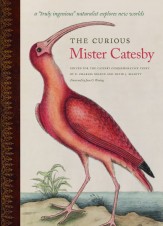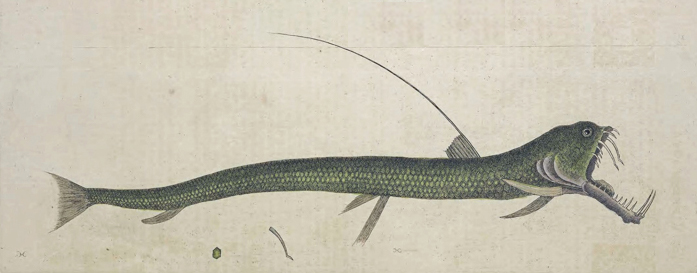
Published – The Curious Mr Catesby: a “truly ingenious” naturalist explores new worlds
The curious Mister Catesby: a “truly ingenious” naturalist explores new worlds
A comprehensive and lavishly illustrated new study of the man and his work, with over 185 color illustrations, by E. Charles Nelson and David J. Elliott and published by The University of Georgia Press (456pp., 2015).
“The Curious Mr. Catesby is beautifully designed and produced and filled with important and interesting scholarship. Congratulations! Well done! I have been savoring it ever since my copy arrived a few weeks ago. The modest Mr. Catesby probably would be surprised by such a substantive volume on his accomplishments, but no doubt very proud!”
—Robert M Peck, Senior Fellow, Academy of Natural Sciences of Philadelphia, Drexel University.
“The Curious Mister Catesby is an absorbing blend of early colonial history in the American Southeast and the Bahamas, with the rich fauna and flora the settlers freshly contained. Catesby emerges as one of the first true naturalists of the New World.”
—E. O. Wilson, University Professor Emeritus of Entomology, Harvard University

Published by the Catesby Commemorative Trust, SHNH is delighted to be one of its sponsors. One of the great classics of American natural history literature, it includes watercolors and descriptions of flora and fauna, some depicted for the first time, such as the extinct Ivory-billed Woodpecker, Carolina Parakeet and Passenger Pigeon. “The Curious Mister Catesby” features 23 chapters by leading experts on varied aspects of Catesby’s broad-ranging interests. The book includes valuable introductory chapters, author notes, and a bibliography. For more information, see www.catesbytrust.org.
The book is being introduced at a series of events in the US and the UK, to which SHNH members are invited. The events will be held in April and May, in Washington DC, New York, Cincinnati, Richmond, Charleston, Atlanta, San Francisco, London & Sudbury. Detailed information on each location is here. All are free and open to the public, but if reservations are noted as being required, please contact Janice Stanley at stellayaris@gmail.com who can make them for you.
Dr. Charles Nelson will speak at every event, joined by Leslie Overstreet at all US locations (except in Savannah, Atlanta and San Francisco, where David Elliott will speak). UK speakers will be Sir Ghillean Prance and Dr. Nelson.
Do watch the promotional video.
The curious Mister Catesby: a “truly ingenious” naturalist explores new worlds
Table of Contents and Author List
Foreword
Introduction
Catesby Chronology
- “The truly honest, ingenious, and modest Mr. Mark Catesby, F. R. S.” – documenting his life, Dr. E. Charles Nelson (FLS: Freelance editor & author, Wisbech, United Kingdom)
- Behind the scenes: Catesby, the man, viewed through the lens of a camera, Cynthia P. Neal (Film producer/director, Nashville, TN)
- Mark Catesby’s botanical forerunners in Virginia, Dr. Karen Reeds (Independent scholar, Princeton, NJ)
- Maria Sibylla Merian (1647-1717): pioneering naturalist, artist, and inspiration for Catesby, Dr. Kay Etheridge (Professor of Biology, Gettysburg College, PA); and Dr. Florence F. J. M. Pieters (Guest researcher, Artis Library, University of Amsterdam, the Netherlands)
- William Dampier (1651-1715): the pirate of exquisite mind, Diana & Michael Preston (Historians and writers, London, United Kingdom)
- John Lawson’s A new voyage to Carolina and his “Compleat History”: the Mark Catesby connection, Dr. Marcus B. Simpson, Jr. (Vice Chair – retired, Dept. of Pathology, Wake Forest University School of Medicine, Winston- Salem, NC)
- Mark Catesby’s world: England, Dr. Janet Browne (Professor of the History of Science, Harvard University, Cambridge, MA)
- Mark Catesby’s world: Virginia, Dr. Sarah Meacham (Associate Professor of History, Virginia Commonwealth University, Richmond, VA)
- Mark Catesby’s Carolina Adventure, Dr. Suzanne Linder Hurley (Historian and author, Davidson, NC)Mark Catesby’s Bahamian natural history (observed in 1725-1726), Dr. Robert Robertson (Emeritus Curator/Malacology, Academy of Natural Sciences, Drexel University, Philadelphia, PA)
- Mark Catesby’s preparatory drawings for The natural history of Carolina, Florida and the Bahama islands, Henrietta McBurney (Formerly Curator of Prints and Drawings, Royal Library, Windsor Castle, United Kingdom)
- The publication of Mark Catesby’s The natural history of Carolina, Florida and the Bahama islands, Leslie K. Overstreet (Curator, Natural History Rare Books, Smithsonian Libraries, Washington, DC)
- The plant collections of Mark Catesby in Oxford Dr. Stephen A. Harris (Druce Curator of the Oxford University Herbaria, Oxford, United Kingdom)
- Carl Linnaeus and the influence of Mark Catesby’s botanical work, Dr. Charles E. Jarvis (Department of Life Sciences, Natural History Museum, London, United Kingdom)
- The economic botany and ethnobotany of Mark Catesby, Dr. Hardy Eshbaugh (Emeritus Professor of Botany, Miami University, Oxford, OH)
- “Of birds of passage”: Mark Catesby and contemporary theories on bird migration and torpor, Dr. Shepard Krech III (Emeritus Professor of Anthropology, Brown University, Providence, RI)
- Catesby’s animals (other than birds) in The natural history of Carolina, Florida and the Bahama islands, Dr. Aaron M. Bauer (Professor of Integrative Biology, Villanova University, Villanova, PA)
- Catesby’s fundamental contributions to Linnaeus’s binomial catalog of North American animals, Dr. Kraig Adler (Professor of Biology and formerly Vice Provost, Cornell University, Ithaca, NY)
- Mark Catesby’s plant introductions and English gardens of the eighteenth century, Mark Laird (Adjunct Professor of the History of Landscape Architecture, Harvard University, Cambridge, MA)
- Following in the footsteps of Mark Catesby, Judith Magee (Library Collections Development Manager, Natural History Museum, London, United Kingdom)
- Inspiration from The natural history of Carolina…by Mark Catesby, Sir Ghillean T. Prance (FRS: Retired Director of the Royal Botanic Gardens, Kew, United Kingdom)
- Conclusions: The Account, Appendix, Hortus and other endings among Mark Catesby’s work, David J. Elliott (FLS: Executive Director, Catesby Commemorative Trust, Charleston, SC)
- APPENDIX: Identification of the plants and animals illustrated by Mark Catesby for The natural history of Carolina, Florida and the Bahama islands, Dr. James L. Reveal (Adjunct Professor of Plant Biology, Cornell University, NY)
Notes to chapters and authors’ acknowledgements
A bibliography for Mark Catesby
Contributors
Indices
Mark Catesby
Mark Catesby (1683 – 1749) grew up in the east of England. His mother’s family, the Jekylls, lived in the Essex village of Castle Hedingham, while his father owned property in, and was mayor of the nearby Suffolk town of Sudbury.
Mark inherited houses and land in Sudbury, as well as houses in London, after his father died in November 1703. Thus he was truly a “gentleman of small fortune” and this legacy probably enabled him to travel to Virginia in 1712 in the company of his older sister, Mrs Elizabeth Cocke, and two of her children. He remained thereabouts for around six years, returning to England by the autumn of 1719.
Three years later, supported by a dozen sponsors including the Duke of Chandos, Catesby returned to North America, this time to South Carolina, to search for animals that he could illustrate and plants that he could send back to Britain for his patrons’ gardens. His explorations ended in the Bahama Islands in 1726. Then, for more than 20 years he painstakingly transferred his sketches of North American plants, birds, fishes and other animals on to copper plates and when these images were printed, he coloured each one by hand himself: “The whole was done within my house, and by my own hands …”. The natural history of Carolina, Florida and the Bahama Islands, published between 1729 and 1747, is a masterpiece, the handiwork of one curious and ingenious man. It was sumptuous in execution and innovative in conception.
Mark Catesby has not been ignored by scholars, but he is less well known that his successors in North American natural history such as Alexander Wilson and especially John James Audubon. In the early 1960s, he was dubbed the “Colonial Audubon” by George Frick and Raymond Stearns. The unearthing of the original watercolours for many of his published plates from the Royal Library in Windsor Castle, where they had lain unstudied since King George III purchased them in 1768, provided further impetus to investigate his life and work. Henrietta McBurney and Amy Myers’s book that accompanied a touring exhibition of a selection of these originals was a significant further contribution. Others who devoted time to researching Catesby’s natural history included the late Joe Ewan who was one of the “pillars” of this Society.
More recently, examination of the animals and plants depicted in the original watercolours (recently made available online by the Royal Collection Trust) have resulted in some revised opinions about what Catesby published. Moreover, it is also clear that not all the subjects were engraved from his own paintings – like others of the period, Catesby was not averse to copying works contained in, for example, Sir Hans Sloane’s collections, and then adapting and publishing them without an acknowledgement of the source. We have also learned that his much younger brother contributed specimens from Gibraltar including a viperfish (now, ironically, known as Sloane’s viperfish).

To mark the tercentenary of Mark Catesby’s arrival in North America, the Catesby Commemorative Trust organized a wide-ranging symposium and invited contributions on all aspects of Catesby’s natural history. Among the international panel of speakers were prominent members of this Society. The presentations, augmented and expanded, have been gathered together as the chapters in The curious Mister Catesby, and have been supplemented with additional studies including a new biography and an up-dated integrated listing, by the late Jim Reveal, of the plants and animals depicted in Catesby’s book and in the Royal Library paintings.
The internet has also played a part. Archived documents, newly available on the worldwide web, yielded new information about Catesby’s family life in London after his return from the Bahamas. He had close associations with Thomas Fairchild, and advertised that likely subscribers to The natural history of Carolina, Florida and the Bahama Islands could inspect the original paintings in Fairchild’s premises in Hoxton. Later, Catesby worked with another nurseryman, Christopher Gray of Fulham, engraving Georg Ehret’s magnificent portrait of a blossom of Magnolia grandiflora for a broadsheet catalogue issued by Gray. A unique hand-coloured copy of this engraving was recognized recently among the botanical illustrations pasted to the wall of Linnaeus’s bedroom in Hammarby.

Mark Catesby (1683 – 1749)
The natural history of Carolina, Florida and the Bahama Islands was issued in 11 parts between May 1729 and July 1747, according to the dates when they were individually presented to the Royal Society. Remarkably, newspaper reports have been found indicating that in May 1729 Catesby, introduced to Court by Lord Carteret, presented a copy of the first part to Queen Caroline. That Catesby and his book about the natural history of North America merited this personal introduction to the Queen Regent was exceptional, as was the praise his book received: “… a Work superior to any Thing of the Kind” being one comment. Dr Cromwell Mortimer, the Secretary of the Royal Society, went so far as to claim that Catesby’s Natural history … was “the most magnificent Work I know of, since the Art of Printing has been discover’d.” The superb copy which Mortimer owned, bound in full russia with his armorial design stamped in gold on the covers, is today in the Smithsonian Institution’s library. The Royal Society retains the copy presented to it by Mark Catesby, while the Royal Library has what must be deemed the author’s personal copy.
Late in life, only two years before he died aged 66, Mark Catesby married Elizabeth Rowland at St George’s Chapel, Hyde Park Corner, a well-known venue for “clandestine” marriages. A son and a daughter were mentioned in Elizabeth Catesby’s will. Yet, the registers of St Giles’s Cripplegate and St Luke’s, Old Street, adjacent London parishes, revealed that four children born to Elizabeth Rowland and Mark Catesby were baptized between April 1731 and December 1737. Two died in infancy. So, Elizabeth and Mark were a highly unconventional couple for at least 18 years.

On 23 December 1749, following a fall while crossing High Holburn, Mark Catesby died, and was buried in the churchyard of St Luke’s, Old Street, London.
© E. Charles Nelson